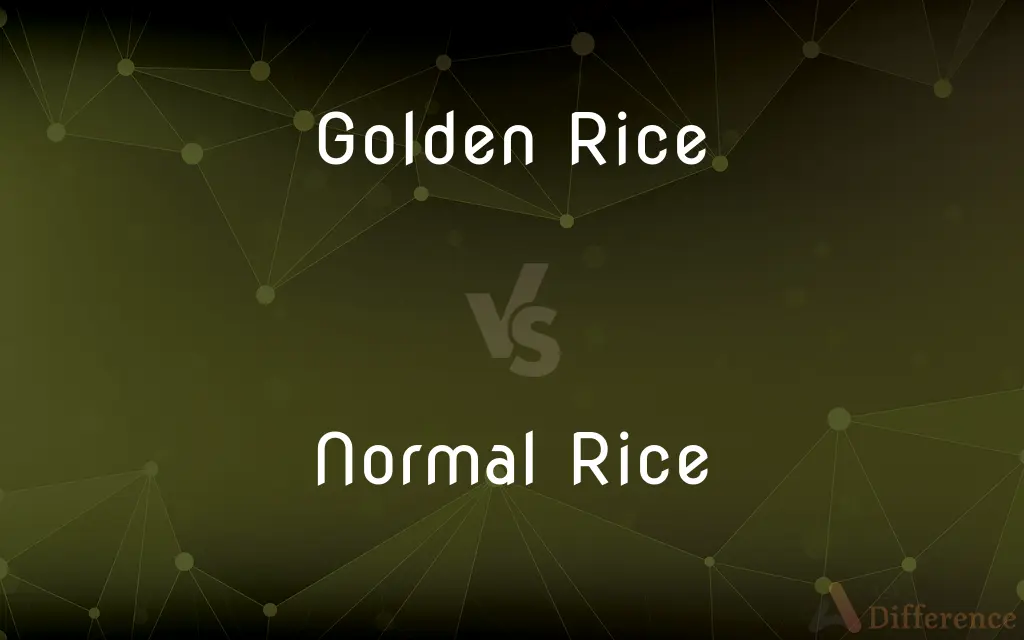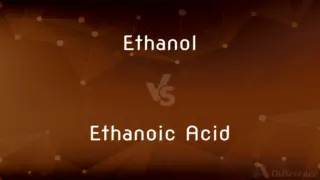Golden Rice vs. Normal Rice — What's the Difference?
By Tayyaba Rehman — Published on January 3, 2024
Golden Rice is genetically modified to produce beta-carotene, giving it a golden color, whereas normal rice is a natural variety without this modification and lacks beta-carotene.

Difference Between Golden Rice and Normal Rice
Table of Contents
ADVERTISEMENT
Key Differences
Golden Rice is a genetically engineered variety of rice that produces beta-carotene, a precursor of vitamin A, in its grains. This modification aims to address vitamin A deficiency in regions where rice is a staple food. Normal rice, on the other hand, naturally lacks significant levels of beta-carotene and therefore does not contribute to dietary vitamin A.
The distinct golden color of Golden Rice comes from the beta-carotene it contains. This is in contrast to normal rice varieties, which typically range in color from white to brown, depending on the type, and do not exhibit the golden hue characteristic of Golden Rice.
In terms of cultivation, Golden Rice is specifically designed for regions with high rates of vitamin A deficiency and is often part of humanitarian projects. Normal rice encompasses a wide range of varieties grown globally for diverse culinary and nutritional needs without the specific aim of addressing micronutrient deficiencies.
Nutritionally, Golden Rice offers an additional health benefit due to its beta-carotene content, potentially improving vitamin A intake among populations that rely heavily on rice as a food staple. Normal rice varieties, while nutritious in terms of carbohydrates and some minerals, do not naturally aid in alleviating vitamin A deficiency.
The development and use of Golden Rice is often surrounded by debates related to genetic modification, agricultural practices, and food security. In contrast, normal rice varieties are traditionally cultivated and have been a part of human agriculture and diet for thousands of years.
ADVERTISEMENT
Comparison Chart
Genetic Modification
Genetically modified to produce beta-carotene
Not genetically modified
Color
Golden due to beta-carotene
White to brown, lacking beta-carotene
Nutritional Purpose
Designed to combat vitamin A deficiency
Provides carbohydrates, lacks significant vitamin A
Cultivation
Aimed for regions with vitamin A deficiency
Grown globally for general consumption
Societal Debates
Surrounds genetic modification and food security
Less controversy, traditional staple food
Compare with Definitions
Golden Rice
Genetically engineered rice
Golden Rice is modified to contain beta-carotene.
Normal Rice
Versatile culinary ingredient
Normal rice is used in a myriad of dishes.
Golden Rice
Biotech humanitarian project
Golden Rice is part of efforts to improve global health.
Normal Rice
Varied in color and type
Normal rice can be white, brown, or even black.
Golden Rice
Source of vitamin A
Golden Rice aims to reduce vitamin A deficiency.
Normal Rice
Major carbohydrate source
Normal rice is a primary carbohydrate in many meals.
Golden Rice
Golden-colored grains
The rice's golden color indicates its beta-carotene content.
Normal Rice
Natural grain
Normal rice is grown without genetic modification.
Golden Rice
GMO rice variant
Golden Rice is a controversial genetically modified crop.
Normal Rice
Traditional staple food
Normal rice is a key part of many diets worldwide.
Common Curiosities
Can normal rice provide vitamin A?
No, it lacks beta-carotene, a precursor of vitamin A.
Are there different types of normal rice?
Yes, including varieties like white, brown, and basmati.
Does normal rice have the same taste as Golden Rice?
Taste can vary, but they are generally similar.
What makes Golden Rice golden?
The presence of beta-carotene gives it the golden color.
Is Golden Rice natural?
No, it's genetically modified to produce beta-carotene.
Why was Golden Rice developed?
To combat vitamin A deficiency in rice-dependent populations.
Is Golden Rice widely accepted?
Its acceptance varies, with some controversy over GMOs.
Is normal rice genetically modified?
Typically, no, it's cultivated through traditional breeding.
Can normal rice help with vitamin A deficiency?
Not effectively, as it lacks beta-carotene.
Can Golden Rice grow like normal rice?
Yes, but it's often grown in specific regions for targeted purposes.
Are both types of rice used in the same dishes?
Yes, Golden Rice can be used in similar dishes as normal rice.
What's the main nutritional difference between them?
Golden Rice provides beta-carotene, a source of vitamin A.
Has Golden Rice been successful in reducing vitamin A deficiency?
Its impact is still being assessed in various regions.
Is Golden Rice safe to eat?
Yes, it's considered safe, like other GMOs approved for consumption.
Can both Golden Rice and normal rice be grown organically?
Normal rice can, but Golden Rice's GMO status complicates organic certification.
Share Your Discovery

Previous Comparison
Ethanol vs. Ethanoic Acid
Next Comparison
Input Devices vs. Output DevicesAuthor Spotlight
Written by
Tayyaba RehmanTayyaba Rehman is a distinguished writer, currently serving as a primary contributor to askdifference.com. As a researcher in semantics and etymology, Tayyaba's passion for the complexity of languages and their distinctions has found a perfect home on the platform. Tayyaba delves into the intricacies of language, distinguishing between commonly confused words and phrases, thereby providing clarity for readers worldwide.












































